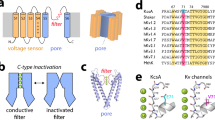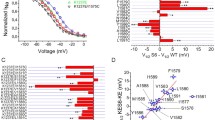Abstract
An N-terminus peptide or a C-terminus mechanism involving a single residue in transmembrane segment 6 produces inactivation in voltage-dependent K+ channels. Here we show that a single position in the pore of K+ channels can produce inactivation having characteristics distinct from either N- or C-type inactivation. In a chimeric K+ channel (CHM), the point reversion CHM V 369I produced fast inactivation and CHM V 369S had the additional effect of halving K+ conductance consistent with a position in the pore. The result was not restricted to CHM; mutating position 369 in the naturally occurring channel Kv2.1 also produced fast inactivation. Like N- and C-types of inactivation, pore or P-type inactivation was characterized by short bursts terminated by rapid entry into the inactivated state. Unlike C-type inactivation, in which external tetraethylammonium (TEA) produced a simple blockade that slowed inactivation and reduced currents, in P-type inactivation external TEA increased currents. Unlike N-type inactivation, internal TEA produced a simple reduction in current and K+ occupancy of the pore had no effect. External TEA was not the only cation to increase current; external K+ enhanced channel availability and recovery from inactivation. Additional features of P-type inactivation were residue-specific effects on the extent of inactivation and removal of inactivation by a point reversion at position 374, which also regulates conductance. The demonstration of P-type inactivation indicates that pore residues in K+ channels may be part of the inactivation gating machinery.
Similar content being viewed by others
References
Armstrong CM (1971) Interaction of tetraethylammonium ion derivatives with the potassium channels of giant axons. J Gen Physiol 58:413–437
Bezanilla F, Armstrong CM (1977) Inactivation of the sodium channel. J Gen Physiol 70:549–566
Busch AE, Hurst RS, North RA, Adelman JP, Kavanaugh MP (1991) Current inactivation involves a histidine residue in the pore of the rat lymphocyte potassium channel RGK5. Biochem Biophys Res Commun 179:1384–1390
Choi KL, Aldrich RW, Yellen G (1991) TEA blockade distinguishes two inactivation mechanisms in voltage-activated K+ channels. Proc Natl Acad Sci USA 88:5092–5095
Demo SD, Yellen G (1991) The inactivation gate of the Shaker K+ channel behaves like an open-channel blocker. Neuron 7:743–753
Frech GC, VanDongen AMJ, Schuster G, Brown AM, Joho RH (1989) A novel potassium channel with delayed rectifier properties isolated from rat brain by expression cloning. Nature 340:642–645
Gonoi T, Hille B (1987) Gating of Na channels. J Gen Physiol 89:253–274
Grissmer S, Cahalan M (1989) TEA prevents inactivation while blocking open K+ channels in human T lymphocytes. Biophys J 55:203–206
Hartmann HA, Kirsch GE, Drewe JA, Taglialatela M, Joho RH, Brown AM (1991) Exchange of conduction pathways between two related K+ channels. Science 251:942–944
Hoshi T, Zagotta WN, Aldrich RW (1990) Biophysical and molecular mechanisms of Shaker potassium channel inactivation. Science 250:533–538
Hoshi T, Zagotta WN, Aldrich RW (1991) Two types of inactivation in Shaker K+ channels: effects of alterations in the carboxy-terminal region. Neuron 7:547–556
Isacoff EY, Jan YN, Jan LY (1991) Putative receptor for the cytoplasmic inactivation gate in the Shaker K+ channel. Nature 353:86–90
Iverson LE, Rudy B (1990) The role of the divergent amino and carboxyl domains on the inactivation properties of potassium channels derived from the shaker gene of Drosophila. J Neurosci 10:2903–2916
Kirsch GE, Drewe JA, Hartmann HA, Taglialatela M, De Biasi M, Brown AM, Joho RH (1992) Differences between the deep pores of K+ channels determined by an interacting pair of non-polar amino acids. Neuron 8:499–505
Kirsch GE, Drewe JA, Taglialatela M, Joho RH, De Biasi M, Hartmann HA, Brown AM (1992) A single nonpolar residue in the deep pore of related K+ channels acts as a K+:Rb+ conductance switch. Biophys J 62:136–144
Koren G, Heinemann SH, Logothetis DE, Nadal-Ginard B, Hess P (1990) Gating mechanism of a cloned potassium channel expressed in frog oocytes and mammalian cells. Neuron 4:39–51
Pardo LA, Heinemann SH, Terlau H, Ludewig U, Lorra C, Pongs O, Stühmer W (1992) Extracellular K+ specifically modulates a rat brain K+ channel. Proc Natl Acad Sci USA 89:2466–2470
Sambrook J, Fritsch EF, Maniatis T (1989) Molecular cloning: a laboratory manual. Cold Spring Harbor Laboratory, Cold Spring Harbor, New York
Solc CK, Aldrich RW (1990) Gating of single non-Shaker A-type potassium channels in larval Drosophila neurons. J Gen Physiol 96:135–165
Stocker M, Stühmer W, Wittka R, Wang X, Müller R, Ferrus A, Pongs O (1990) Alternative shaker transcripts express either rapidly inactivating or noninactivating K+ channels. Proc Natl Acad Sci USA 87:8903–8907
Taglialatela M, VanDongen AMJ, Drewe JA, Joho RH, Brown AM, Kirsch GE (1991) Patterns of internal and external tetraethylammonium block in four homologous K+ channels. Mol Pharmacol 40:299–307
Timpe LC, Jan YN, Jan LY (1988) Four cDNA clones from the Shaker locus of Drosophila induce kinetically distinct A-type potassium currents in Xenopus oocytes. Neuron 1:659–667
Timpe LC, Schwarz TL, Tempel BL, Papazian DM, Jan YN, Jan LY (1988) Expression of functional potassium channels from Shaker cDNA in Xenopus oocytes. Nature 331:143–145
VanDongen AMJ, Frech GC, Drewe JA, Joho RH, Brown AM (1990) Alteration and restoration of K+ channel function by deletions at the N- and C-termini. Neuron 5:433–443
Zagotta WN, Aldrich RW (1990) Voltage-dependent gating of Shaker A-type potassium channel in Drosohila muscle. J Gen Physiol 95:29–60
Zagotta WN, Brainard MS, Aldrich RW (1988) Single-channel analysis of four distinct classes of potassium channels in Drosophila muscle. J Neurosci 8:4765–4779
Zagotta WN, Hoshi T, Aldrich RW (1989) Gating of single Shaker K+ channels in Drosophila muscle and in Xenopus oocytes injected with Shaker mRNA. Proc Natl Acad Sci USA 86:7243–7247
Zagotta WN, Hoshi T, Aldrich RW (1990) Restoration of inactivation in mutants of Shaker potassium channels by a peptide derived from ShB. Science 250:568–571
Author information
Authors and Affiliations
Rights and permissions
About this article
Cite this article
De Biasi, M., Hartmann, H.A., Drewe, J.A. et al. Inactivation determined by a single site in K+ pores. Pflügers Arch. 422, 354–363 (1993). https://doi.org/10.1007/BF00374291
Received:
Revised:
Accepted:
Issue Date:
DOI: https://doi.org/10.1007/BF00374291




